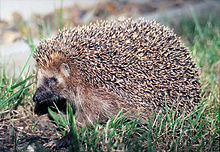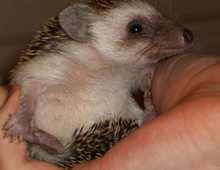Hey, it’s a hedgehog!

Few of us in the Americas can say this, since the hedgehog habitat is Europe, Asia and Africa. Yet we see them in advertising, cartoons and video games, often with fruit stuck to their quills. We tend to assume they are vegetarians as scary as porcupines, and they must be very agile to get the food on their backs.
This is a wholly inaccurate conception. The Erinaceus europaeus is actually an omnivorous mammal more related to the shrew than the porcupine. Their spines are neither poisonous nor barbed, and are usually only shed as the teacup-sized animal reaches adulthood, much like human baby teeth being replaced with permanent teeth; this process is called “quilling”. They are shy and nocturnal, so even where they live naturally, few of the 15 species are seen during the day.
The earliest known use of the term hedgehog arose around 1450. It was found hanging around under hedgerows and has a snout similar to the pig; hence the name. Their color patterns can be salt-and-pepper, cinnamon, chocolate, snowflake, panda, mocha, cream, silver point, albino and spotted, with many variations, depending on the species.
The spines are hairs stiffened by keratin (which is the main constituent of human fingernails). In desert conditions, there are fewer spines so that the weight is lower. When threatened, the hedgehog rolls up into a ball with the spines facing outward. Having fewer spines, a desert hedgehog might flee instead, or possibly ram an intruder with the spines. There are two large muscles on its back which control the position of the quills. On average, there are 5,000 to 6,500 quills, each filled with air pockets.

During the day, hedgehogs usually sleep under bushes, grass or rocks, or in underground dens. Wild hedgehogs will hibernate if temperature or the scarceness of food make it a good idea. When hibernating their body temperature will drop from the normal 86-95 F down to 36-41F. Those who live in deserts will sleep through heat and drought (estivation). Those in temperate locales will be active year round. While they may appear to be mute, they actually communicate with grunts, snuffles and squeals.
On their nightly rounds, hedgehogs will eat insects, toads, lizards, snakes, snails, frogs, carrion, grass roots, bird eggs, berries, and melons. Since their eyesight is weak, they depend more on hearing and smell to find food. Sometimes people like to keep them as pets to control common garden pests. If, while wandering for food, it encounters a new scent, it will lick and bite the source, then make a scented froth in its mouth, which it deposits onto its spines with its tongue. Some people think that this “anointing” ritual allows the mammal to blend in with the surrounding scents; others think this may be a method of infecting predators with a poison.
The lifespan of a hedgehog is longer than usual for mammals of the same size. Larger ones live 4-7 years, and have even been recorded to live up to 16 years; smaller species live 2-4 years.
When reproducing, these usually-solitary animals will get together only long enough to create a family, once a year. Females carry their young for 35-58 days, with an average litter of 3-4 (larger species) or 5-6 (smaller species). They are born blind, with a protective membrane over the quills. This membrane dries and shrinks over the first few hours, when the mother may clean it off or it falls off. The quills then emerge through the skin. Four to seven weeks after birth, the young will go off on their own. Even with these sweet-looking animals, adult males will often kill newborn males. Females will eat their young if the nest is disturbed, if they don’t simply move to a new nest.
Predators for the forest hedgehogs are birds, especially owls, and ferrets. Smaller species like the long-eared hedgehog may be consumed by wolves, foxes and mongooses. Humans are ‘predators’ when cars run them over, or when they are kept as pets and not handled properly. These animals have been introduced in areas where there are no natural predators, as in New Zealand and Scotland. This was a mistake, as the hedgehogs became pests, wiping out native species such as snails, insects and ground-nesting birds. Humans have occasionally adopted hedgehogs as food. This was true in ancient Egypt and during the late middle ages in Europe. Their meat is still sold for medicine and witchcraft in Eurasia and Africa. Bedouins in the Middle East believe the meat can cure rheumatism and arthritis, and in some cultures tuberculosis. Moroccans inhale the smoke of the burned skin or quills to cure male impotence, fever, and urinary infections. Their blood is believed to cure ringworm, cracked skin and warts. Current day Romans still eat the boiled or roasted flesh.

Hedgehogs also have to cope with disease. Squamous cell carcinoma, a cancer, is very common. They suffer from ringworm and will transmit it to other hedgehogs as well as human handlers. These little critters eagerly eat high-fat and high-sugar foods, though their metabolism is adapted for protein-rich low-fat insects. This taste for unhealthy foods leads to obesity, fatty liver disease and heart disease.
Curiously, along with moles, pigs, mongooses, honey badgers and opossums, hedgehogs have a natural immunity to some snake venoms.
Because they are cute, small, and quiet, it would seem that “hedgies” would be good pets. But they must be handled carefully, kept away from children, and purchased from licensed dealers. They are never ‘domesticated’ and cannot be trained. Hedgehogs are deemed exotic pets, prohibited in Georgia, Pennsylvania, California, Maine, Alabama, Hawaii and Vermont. Ownership is restricted in Maine, New Jersey, Arizona and Oregon. In some Canadian municipalities, Scandinavia, the United Kingdom and Italy, hedgie ownership is banned or seriously restricted.
It appears it is better to leave them to the wild, since they require a lot of care and their food and veterinary expenses are high. If you are lucky enough to live in an area where they live naturally, enjoy the garden pest control – and leave the occasional berries and melons out for dessert.
© 2016 Bonnie-Jean Rohner




